Contents
Market Overview
Macro Review
What’s another CNY560bn? Well, that’s the aggregate PBoC injection over the last two weeks, which corresponds to a net injection of CNY460bn. The PBoC is clearly intent on stabilizing domestic markets, but the willingness to stabilize Evergrande is less clear. The company did not pay the USD coupon, and instead entered the 30-day grace period. Contagion on Monday at the start of the week saw the S&P dip below the 50dma, the VIX spike, iron ore sold-off and investors flocked to safe-haven and oil-related assets (including NOK and EMFX currencies). Sentiment reversed and recovered into Powell’s FOMC presser, which was surprisingly hawkish with the Fed finally meeting market expectations. The Summary of Economic Projections (SEPs) highlighted that the Fed is sticking to the transitory view, but stretching the definition. Growth has been revised down to 5.8% for 2021 (from 7.0%) but next year was taken up to 3.8% (previously 3.3%). However, PCE inflation was increased by 80bps to 4.2% and Core PCE was moved up by 70bps to 3.7% (noteworthy that it remains above 2% for 2022 and 2023). The conversation on tapering has begun and dots are split in 2022 (one hike on rounding but three hikes in 2023 and in 2024), which in turn triggered volatility in Eurodollar futures (i.e. a 2023 Fed Funds Rates median of 1.0%). Aside from the Fed meeting, the G10 calendar was heavy with the Bank of England, Bank of Japan, Riksbank and Norges Bank. Within EM, Russia hiked 25bps last Friday, which followed Hungary’s 15bps hike this week, but both fell shy of expectations. The idea that EM central banks have dovish-ly hiked rates is still misplaced: Russia has hiked 250bps this year, and real policy rates are positive. Hungary’s tightening cycle is 105bps, albeit from a lower base, but still exceeds Czech Republic (50bps), while Poland and Romania are yet to move policy rates. However, Hungary’s inflation is still above target and comes as PM Orban seeks to raise wages by at least 20%, which is in part through a tax refund. Interestingly, Hungary is raising rates while tapering, which is an idea that the Fed still dismisses. Otherwise, Brazil remained on autopilot. Having hiked rates another 100bps this week, the cushion with real rates now exceeds 5%, which offers some firepower into an election year in 2022. Needless to say, Asian central banks have remained grounded, with only South Korea hiking rates so far (a mere 25bps). Counter to all of the above, Turkey’s CBRT cut rates by 100bps in a surprise move that caused assets to reprice with a weaker lira (>8.75), with CDS +10bps wider which repriced sovereign and corporate bonds by some 10-20bps. However, the major volatility on Thursday focused squarely on the Bank of England’s hawkishness, and to a lesser extent, the 25bps hike from Norge’s Bank. These events spun the global rates market wider.
EM Credit Update
EM credit ended the week down 0.6% with HY down 1.0% as volatility rocked markets. U.S. Treasuries initially bear flattened with the 10yr and 30yr touching 1.30% and 1.80% in the aftermath of the FOMC, but sold-off on Thursday with European rate weakness. Gilts repriced European rates 6-11bps wider, which weighed on U.S. Treasuries, and in turn sent Australian and New Zealand rates 10-14bps wider in Friday’s session. We saw a three standard deviation move in U.S. Treasuries, with the 10yr widening 13bps at one point, reflecting the largest one-day move since February 25th (the day of the weak 7yr auction). Lithuania, Belize and Papua New Guinea outperformed, while Zambia, Argentina and El Salvador lagged. After the $36bn in primary issuance last week the supply trends eased, although we did see $7bn in Single B sovereign issuers (Egypt and Nigeria).
The Week Ahead
The focus over the weekend will sit with German elections before shifting to Japan. Amidst those events, China will publish official and Caixin PMIs for September. After seven EM central bank decisions last week, we’ll have another six coming up from Colombia (1.75%), Czech Republic (0.75%), Ghana (13.5%), Kenya (7.0%), Mexico (4.5%) and Thailand (0.5%). Beyond that, inflation releases out of Indonesia, Peru and Poland are due, followed by Turkey’s trade deficit release. Brazil’s Copom minutes could also be a market event after the recent 100bps hike, as they have guided a further 100bps increase before year-end.
Highlights from emerging markets discussed below include: Argentina’s cabinet reshuffle leaves Guzman in post, the Central Bank of Turkey initiates pre-mature monetary policy easing cycle under political pressure, U.S. sanctions risk for Russia back on investors’ radars, but escalation unlikely in the near-term and global emerging markets corporates in focus: Word of the week? Contagion!
Fixed Income
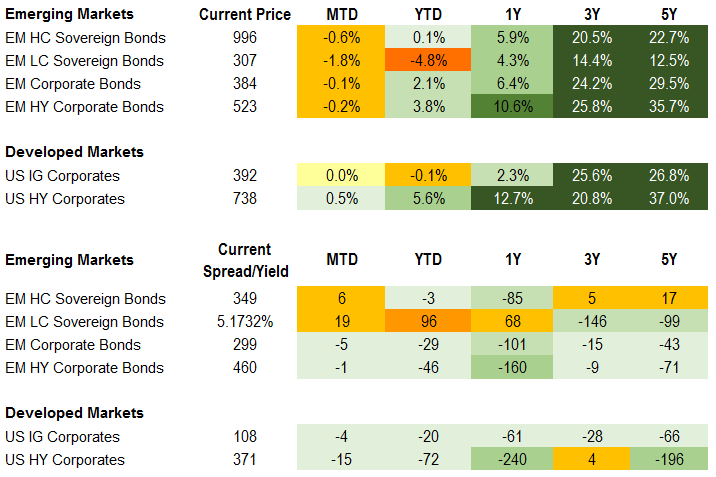
Equities
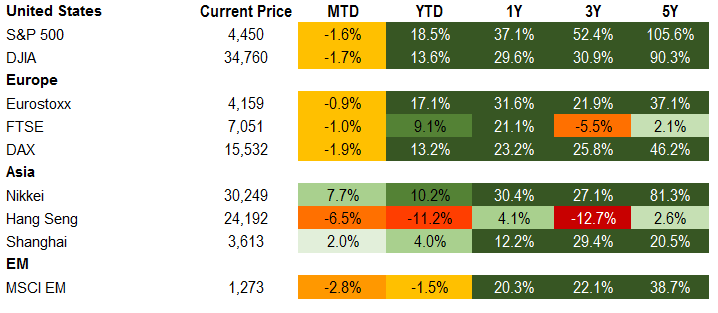
Commodities

Source for data tables: Bloomberg, JPMorgan, Gramercy. EM Fixed Income is represented by the following JPMorgan Indicies: EMBI Global, GBI-EM Global Diversified, CEMBI Broad Diversified and CEMBI Broad High Yield. DM Fixed Income is represented by the JPMorgan JULI Total Return Index and Domestic High Yield Index. Fixed Income, Equity and Commodity data is as of September 24, 2021 (mid-afternoon).
Emerging Markets Weekly Highlights
Argentina’s cabinet reshuffle leaves Guzman in post; policy to remain election oriented through November
Event: Following last week’s political stand-off between President Alberto Fernandez and Vice President Cristina de Fernandez Kirchner, Fernandez announced cabinet changes including the Chief of Cabinet, Press Secretary, Ministries of Foreign Affairs, Security, Agriculture, Science & Technology, and Education. Among the more controversial adjustments was the Chief of Cabinet who is now Juan Manzur, former Governor of the Tucumán province and Minister of Health during CFK’s second term as president. Economy Minister, Martin Guzman, has been kept in his post.
Gramercy Commentary: As outlined last week, we view this short-term solution as the least disruptive as it keeps Guzman in place but placates Cristina. This should keep market expectations for an ultimate IMF deal intact but reflects CFK’s frustrations with the coalition’s electoral performance and intent to improve the outcome in November through populist measures and spending. The year-to-date primary fiscal deficit of roughly 1% of GDP leaves the government with 3% of GDP to deploy between now and year-end to still comply with Guzman’s target of 4% of GDP. Limited financing will require the government to continue to rely on deficit monetization with inflationary consequences, leaving the government with little room to maneuver thereafter, and in theory, further supporting the need for an IMF resolution.
The Central Bank of Turkey initiates pre-mature monetary policy easing cycle under political pressure, increasing economic and market risks in the coming months
Event: Turkey’s Central Bank (CBRT) cut its main policy rate by 100bps to 18% and hinted at further interest rate decreases in the coming months.
Gramercy Commentary: The easing of monetary policy comes as a surprise to market participants who overwhelmingly expected rates to remain on hold in September against a backdrop of sticky, still accelerating, headline inflation (CPI came in at 19.25% in August) and earlier reassurances by governor Kavcioglu that the policy rate will remain “above the inflation rate”. We see the decision to cut rates as pre-mature and credit negative, highlighting Turkey’s deteriorating economic policy environment since the abrupt firing of Kavcioglu’s predecessor back in March. We think that the CBRT is committing a significant policy mistake that will likely introduce further weakness/volatility in Turkish assets in the coming months. Unlike the previous monetary policy easing cycle that started in July 2019 (following earlier rate hikes to 24% in response to the 2018 currency crisis) when inflation was on a clear downward path, the current cycle is being initiated in the context of still accelerating inflation and unanchored inflation expectations. As a result, onshore real rates have fallen deeper into negative territory, undermining the currency (TRY) and dragging other assets and sentiment with it. We expect these market-negative trends to continue under the developing policy outlook and we think the CBRT’s already low market credibility will suffer a further blow due to the fluid and inconsistent justifications used by its leadership to support the politically mandated rate cuts. In addition, our analysis shows that the current account (CA) has not adjusted sufficiently to justify lowering funding rates (again unlike in 2019), exposing Turkey’s balance of payments, FX reserves, and investors/savers’ confidence to higher risks. We expect the tentative improvement in the CA deficit seen over the last few months to reverse amid the starting easing cycle, which will likely attract closer market attention to this vulnerability in the coming weeks/months. In this environment, we expect market pressures on Turkey to gradually intensify, subject to external conditions (Fed & ECB policy), geopolitics and, above all, the CBRT’s own policy trajectory and guidance.
U.S. sanctions risk for Russia back on investors’ radars, but escalation unlikely in the near-term
Event: Two amendments to the 2022 National Defense Authorization Act (NDAA) being considered by the U.S. House of Representatives this week contain proposals to ramp-up sanctions against Russian entities and individuals, including blocking U.S. persons from trading Russian sovereign debt in secondary (in addition to primary) markets.
Gramercy Commentary: If these proposals survive the legislative process and make it to the NDAA final version, it would constitute a meaningful escalation of U.S. sanctions pressure on Russia, beyond what markets have been discounting. However, we believe this scenario carries a low probability, judging by historical precedent (i.e. similar proposals in prior years that have eventually been dropped from final versions of policy documents) and the Biden White House’s recent foreign policy signals in terms of managing relations with the Kremlin. In addition to offering some “carrots” to Moscow, we think Washington would prefer to preserve its most impactful “sticks” in the event the ongoing diplomatic reset fails to live up to its modest expectations. From that perspective, using one of the main weapons in the arsenal (i.e. tightening sanctions on sovereign debt, including on secondary trading) would likely be seen as counterproductive and the Biden Administration would prefer to save it for another time, in our view. As such, we believe that a market-disruptive event will likely be avoided, at least until the U.S. 2022 mid-term elections cycle kicks in with full force in the first half of next year. In addition, we expect President Biden/the executive branch to retain final approval/waiver authority on any future potential sanctions on Russia. This would further mitigate sanctions risk in the near-term, given a traditionally stronger appetite for punitive actions against Russia on Capitol Hill.
Global emerging markets corporates in focus: Word of the week? Contagion!
Event: Concerns about potential contagion from China Evergrande Group sent shockwaves through the market early in the week, causing spreads to widen in names that have little or nothing to do with the Chinese real estate sector. These shockwaves have caused some to conclude that Evergrande may be ‘China’s Lehman Brothers’. The fundamental metrics of the emerging market corporate universe are worth discussing in this context.
Gramercy Commentary: Gross margins in emerging markets are lower than in 2008. Based on data from Bank of America, these margins exceeded 30% in 2008 but had declined somewhat, to 26% by the end of 2020. In addition, gross and net leverage are higher than in 2008, though net leverage in emerging markets is much lower than in the U.S. (2.5x in EM versus 3.2x in the U.S.). The short-term portion of total debt has not changed much relative to 2008 (as a percentage of total debt). However, cash coverage of short-term debt has improved to 1.5x from 1.3-1.4x in 2008. In addition, going into 2008 year-on-year increases in total debt were much higher than in 2020. Further, cash balances rose more significantly in 2020 than in 2008 and emerging market corporates were cutting capex and general costs in 2020, unlike in 2008. Significant uncertainties regarding Evergrande remained at the time of writing. As is well known, the exposure of the Chinese banking system to this singular borrower group appears manageable. Added to this, China’s financial regulators have aired concerns about real estate-related risks for some time, with previous reports suggesting banks had been asked to stress test certain exposures. Nonetheless, on the path to a resolution at Evergrande, there is bound to be even more volatility – China Huarong Asset Management Company has very recently shown that (though it is important to stress that the issues there were different). Navigating the volatility will undoubtedly involve more frequent and in-depth assessments of emerging market corporate credit exposures and close monitoring of inevitable dislocations; mainstays of active portfolio management.
Emerging Markets Technicals
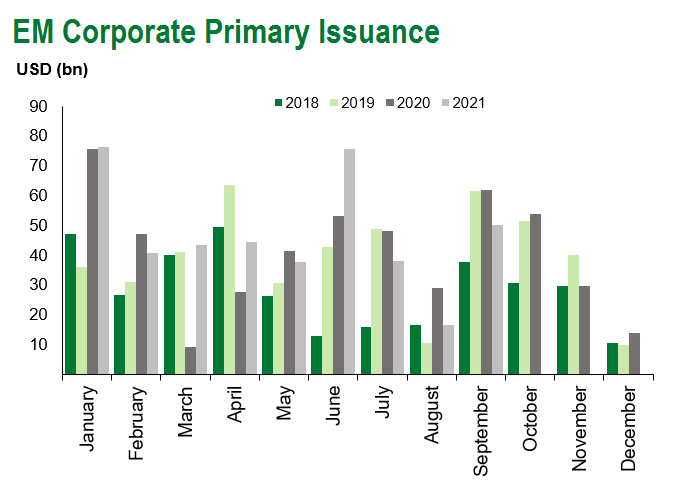
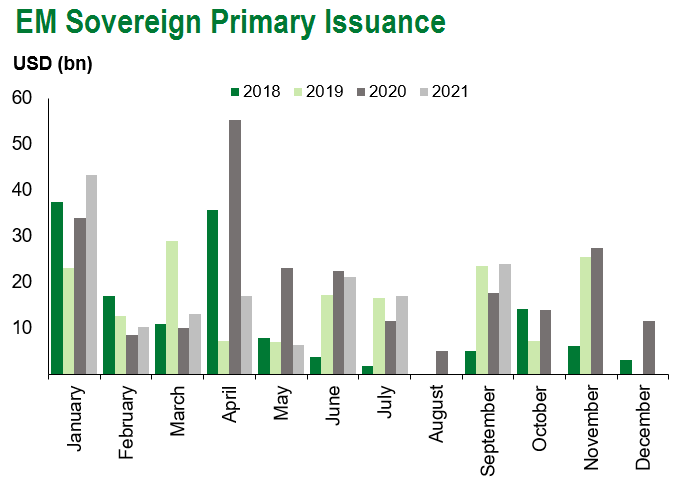
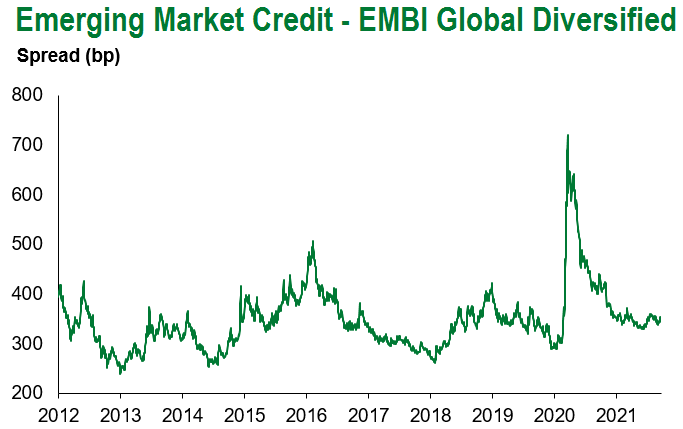
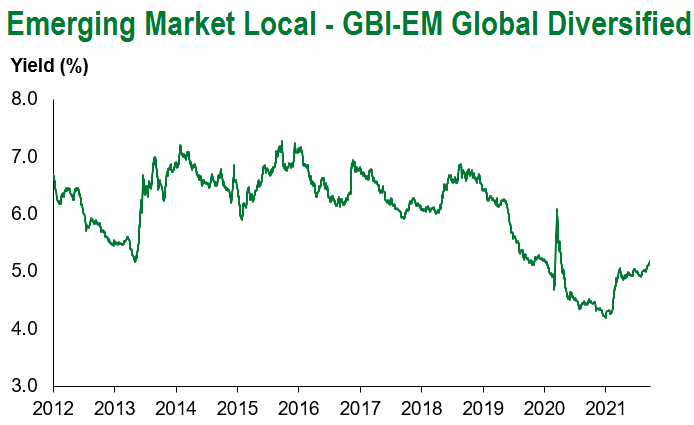
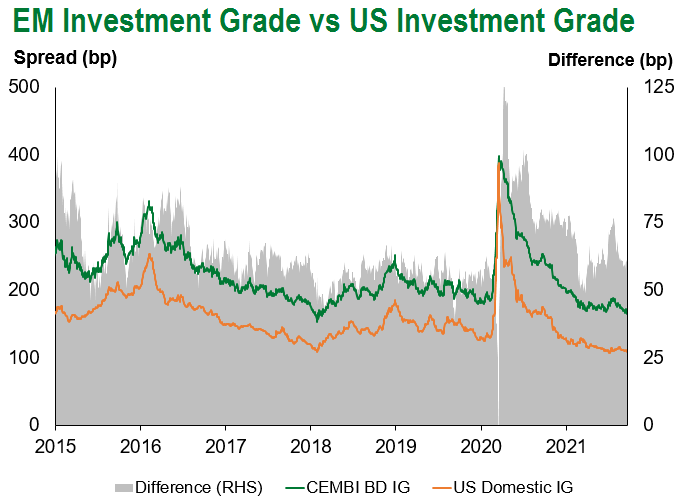
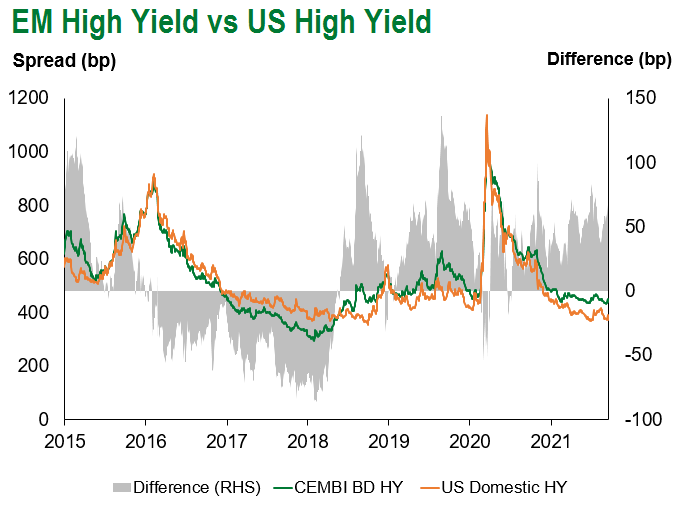
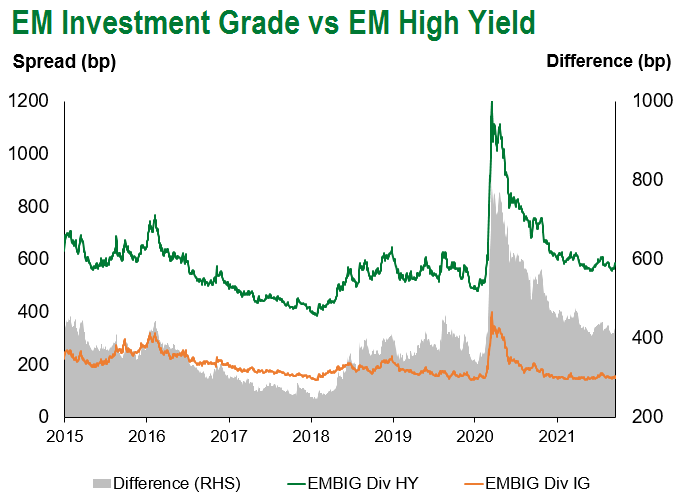
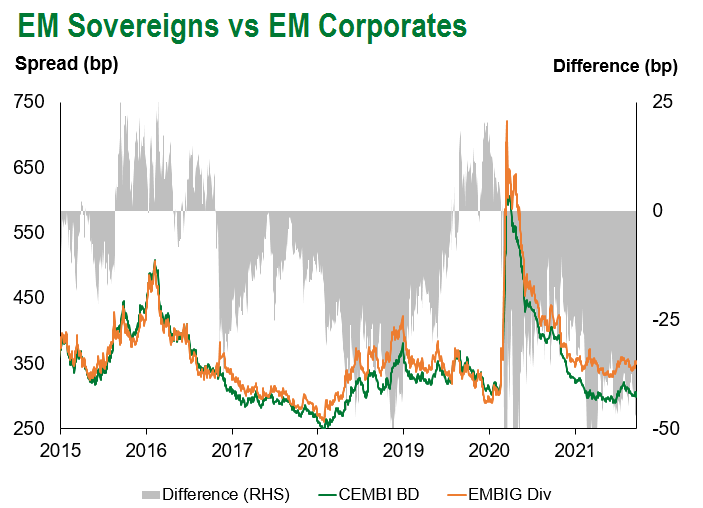
Emerging Markets Flows
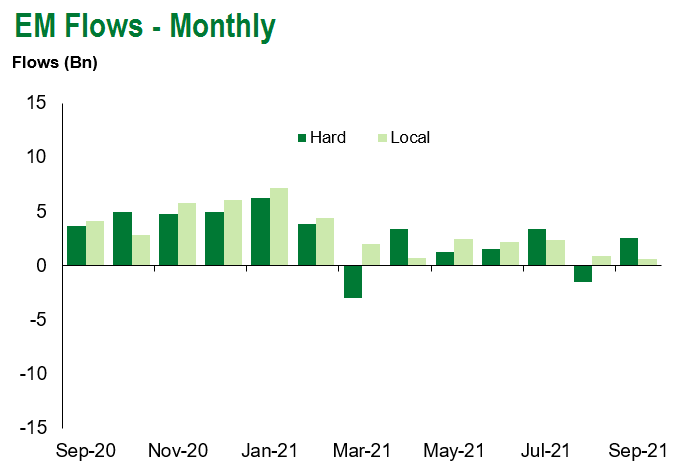
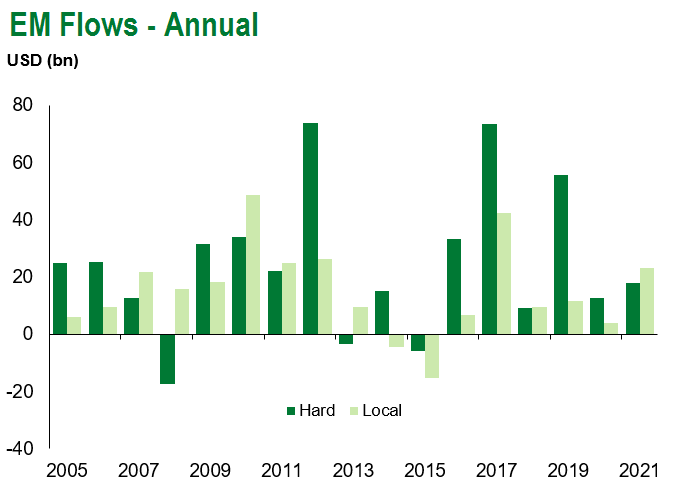
Source for graphs: Bloomberg, JPMorgan, Gramercy. As of September 24, 2021.
COVID Resources
Emerging Markets COVID-19 Case Summary
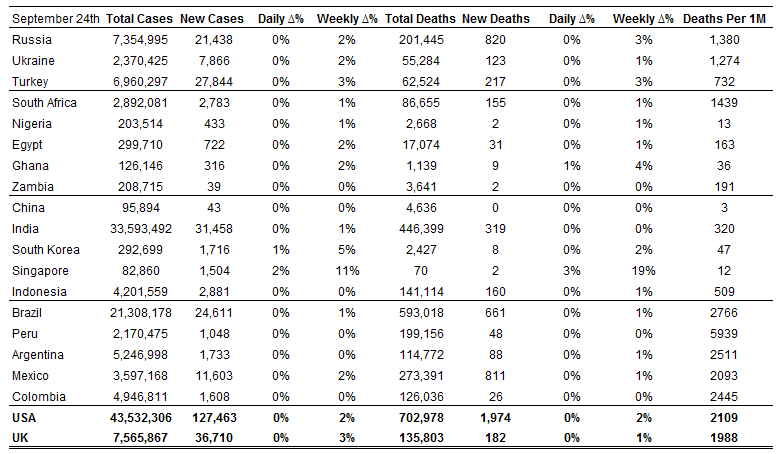
Source: Worldometer as of September 24, 2021.
Additional Crisis Resources:
Johns Hopkins COVID-19 Case Tracker
For questions, please contact:
Kathryn Exum, Senior Vice President, Sovereign Research Analyst, [email protected]
Petar Atanasov, Senior Vice President, Sovereign Research Analyst, [email protected]
Tolu Alamutu, CFA, Senior Vice President, Corporate Research Analyst, [email protected]
James Barry, Vice President, Corporate Research Analyst, [email protected]
This document is for informational purposes only. The information presented is not intended to be relied upon as a forecast, research or investment advice, and is not a recommendation, offer or solicitation to buy or sell any securities or to adopt any investment strategy. Gramercy may have current investment positions in the securities or sovereigns mentioned above. The information and opinions contained in this paper are as of the date of initial publication, derived from proprietary and nonproprietary sources deemed by Gramercy to be reliable, are not necessarily all-inclusive and are not guaranteed as to accuracy. This paper may contain “forward-looking” information that is not purely historical in nature. Such information may include, among other things, projections and forecasts. There is no guarantee that any forecasts made will come to pass. Reliance upon information in this paper is at the sole discretion of the reader. You should not rely on this presentation as the basis upon which to make an investment decision. Investment involves risk. There can be no assurance that investment objectives will be achieved. Investors must be prepared to bear the risk of a total loss of their investment. These risks are often heightened for investments in emerging/developing markets or smaller capital markets. International investing involves risks, including risks related to foreign currency, limited liquidity, less government regulation, and the possibility of substantial volatility due to adverse political, economic or other developments. The information provided herein is neither tax nor legal advice. Investors should speak to their tax professional for specific information regarding their tax situation.